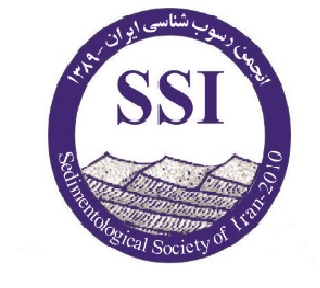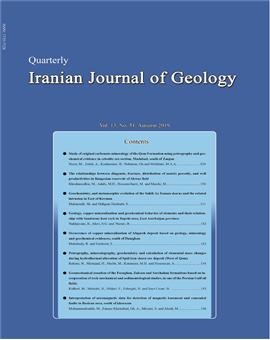Geomechanical zonation of the Faraghan, Zakeen and Sarchahan formations based on incorporation of rock mechanical and sedimentological studies, in one of the Persian Gulf oil fields
Subject Areas :Mehran Kalhori 1 , Hooshang Mehrabi 2 , Ebrahim Sefidari 3 , Hasan Eshraghi 4 , Behnam Vaez Livari 5
1 -
2 -
3 - Tehran University
4 -
5 -
Keywords: Sedimentary facies Mechanical earth model Faraghan Zakeen Clustering ,
Abstract :
Geomechanical studies have important applications in various topics such as wellbore stability, well completion, well orientation, hydraulic fracturing plans and operations, sand production and hydrocarbon fields subsidence. It is necessary to prepare earth mechanical model of the well in the field. In addition, one of the necessary subjects to prepare mechanical earth model (MEM) is providing continuous rock mechanical parameters in the well. Rock mechanical parameters change by any variation in lithology. In this study, rock mechanical parameters are provided in continuous form, for Faraghan, Zakeen and Sarchahan formations for a field in the Persian Gulf and these parameters are clustered. Clustering resulted in recognizing six clusters with various rock mechanical characteristics. Petrographic study (i.e. determining facies, cementation and diagenesis) recognized five facies with different petrographic and cementation characteristics. These facies include quartz arenite and arkosic sandstones, shales, red mudstone and carbonates. A correlation between sedimentary and geomechanical facies was found. According to petrographic and geomechanical studies, the studied interval was divided into 7 sections. Accordingly, variation of rock mechanical parameters with regard to change in lithology was investigated. In addition, the impact of rock composition, cementation and compaction changes on rock mechanical parameters were evaluated as well.
Bernab, Y., Frye, D. and Hayes, J., 1992. The Effect of Cement on the Strength of Granular Rocks. Geophysical Research Letters, 19, 1511-1514.
Brenchley, P., Marshall, J., Carden, G., Robertson, D.B.R., Long and Anderson, T., 1994. Bathymetric and isotopic evidence for a short-lived Late Ordovician glaciation in a greenhouse period. Geology, 22,4, 295-298.
Cantisani, E., Garzonio, C., Ricci, M. and Vettori, S., 2013. Relationships between the petrographical, physical and mechanical properties of some Italian sandstones. International Journal of Rock Mechanics and Mining Sciences, 60, 321–332.
Charsky, A., Pyles, D. and Sonnenberg, S., 2017. Integrating Mineralogy, Process Sedimentology and Geomechanics for Development of a Mechanical Stratigraphy Model of the Bakken Formation. Unconventional Resources Technology Conference. Austin, Texas, USA: SPE.
Detournay, E. and Cheng, A.D., 1988. Poroelastic response of a borehole in a non-hydrostatic stress field, in International Journal of Rock Mechanics and Mining Sciences & Geomechanics Abstracts, pp. 171-182.
Dunham, R. J., 1962. Classification of carbonate rocks according to depositional texture. In: Ham, W. E. (ed.), Classification of carbonate rocks. American Association of Petroleum Geologists Memoir.
Fjar, E. H., 2008, Petroleum related rock mechanics, Elsevier.
Ghavidel-Syooki, M., 1998. Investigation on the upper Paleozoic Strata in Tang-e-Zakeen, and introducing Zakeen formation, Kuh-e Faraghan Zagros Basin, South Iran. Geosciences, 29, 54-73.
Hsieh, Y.M., Li, H.H., Huang, T.H. and Jeng, F.S., 2008. Interpretations on how the macroscopic mechanical behavior of sandstone affected by microscopic properties—Revealed by bonded-particle model. Engineering Geology, 99, 1-10.
Khaksar, A., Taylor, P., Fang, Z., Kayes, T., Salazar, A. and Rahman, K., 2009. Rock Strength from Core and Logs: Where We Stand and Ways to Go . SPE 121972.
Lüning, S., Craig, J., Loydell, D., Štorch, P. and Fitches, B., 2000. Lower Silurianhot shales' in North Africa and Arabia: regional distribution and depositional model. Earth-Science Reviews, 49,1, 121-200.
Pettijohn, F., 1975. Sedimentary Rocks. Harper and Row, NEW YORK.
Plumb, R., 1994. Influence of composition and texture on the failure properties of clastic rocks. Eurock SPE/ISRM Rock Mechanics. Delft, Netherlands: SPE.
Revelle, W., 1979. Hierarchical cluster analysis and the internal structure of tests. Multivariate Behavioral Research, 14,1, 57-74.
Schandelmeier, H. and Reynolds, P., 1997. Paleogeographic–Paleotectonic Atlas of North–Eastern Africa. Arabia and Adjacent Areas. Rotterdam, Netherlands, Balkema.
Sfidari, E., Kadkhodaie-Ilkhchi, A., Rahimpour-Bbonab, H. and Soltani, B., 2014. A hybrid approach for litho-facies characterization in the framework of sequence stratigraphy: A case study from the South Pars gas field, the Persian Gulf basin. Journal of Petroleum Science and Engineering, 121, 87-102.
Stern, R. and Johnson, P., 2010. Continental lithosphere of the Arabian Plate: a geologic, petrologic, and geophysical synthesis, Earth-Science Reviews, 101(1), 29-67.
Zare-Reisabadi, M., Kaffash, A. and Shadizadeh, S., 2012. Determination of Optimal well trajectory during drilling and production based on borehole stability, International Journal of Rock Mechanics and Mining Sciences, 56, 77-87.
Zeynali, M. E., 2016. Mechanical and physico-chemical aspects of wellbore stability during drilling operations, Journal of Petroleum Science and Engineering, 82-83, 120-124.
Zoback, M., 2010. Reservoir geomechanics, Cambridge University Press.

